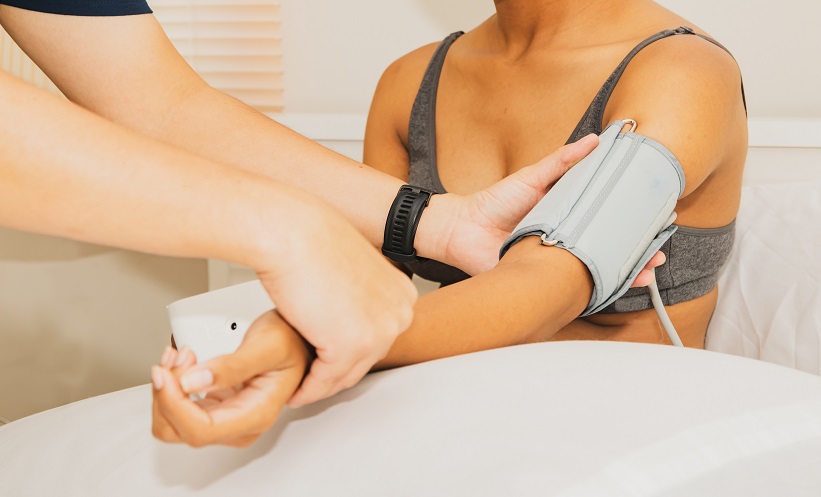The following highlights cover several innovative and thought-provoking abstracts from the 38th Annual Meeting of the European Society of Human Reproduction and Embryology (ESHRE), featuring topics such as artificial intelligence in fertility treatments, a potential biomarker for endometriosis, and the use of testosterone therapy in in vitro fertilisation.
Could a Small Extracellular Vesicle Protein Cargo Be a Biomarker for Endometriosis?
ACCORDING to a study presented at the ESHRE 2022, which took place on 3rd–6th July, researchers identified that small extracellular vesicles (sEV) could be a biomarker for endometriosis. Females with endometriosis experience pain and subfertility; however, the cause of the disease is unknown. Although sEV are produced by nearly every cell, they have been identified in diseases such as cancer, pre-eclampsia, and diabetes, as well as endometriosis. The researchers for this study aimed to confirm if peritoneal fluid (PF) sEV could be utilised as a biomarker for endometriosis.
Samples of PF were acquired from the Endometriosis CaRe Centre, Nuffield Department of Women’s and Reproductive Health, University of Oxford, UK. Females between 18–49 years old who had undergone diagnostic laparoscopy were organised according to their cycle phase, either proliferative, secretory, or menstrual, and according to the severity of endometriosis as per the American Society for Reproductive Medicine (ASRM) stages. The criteria for exclusion were based on ongoing hormonal treatment, malignancy, pregnancy, breastfeeding, and lack of ability to understand the consent form. In order to remove cells, debris, and microvesicles, 1 mL of PF from each sample was centrifuged. The sEV was isolated via size exclusion chromatography and investigated by a nanoparticle tracking analysis, immunoblotting, and mass spectrometry (liquid chromatography with tandem mass spectrometry).
The results showed the existence of exosomes in PF in both females at different stages of endometriosis as well as participants without the disease. Additionally, sEV concentrations were higher in females with endometriosis compared to the control group and were highest in Stage III–IV endometriosis. The concentration of sEV in Stage III–IV endometriosis declined as the samples of PF shifted from proliferative to secretory cycle phases. Earlier studies have demonstrated CD44 as the sEV protein uniquely found in endometriosis, and this study aligned with this finding. In conclusion, the authors believe that the existence of CD44 within sEV could help diagnose endometriosis.
Viability of Embryo by the Use of Whole Genomic Amplification in Blastocoelic Fluid
A STUDY presented at ESHRE 2022, which took place on 3rd–6th July, stated that blastocysts with DNA in the blastocoelic fluid (BF) have lower ongoing pregnancy rates compared with blastocysts without DNA, both in preimplantation genetic screening (PGT-A) and in standard in vitro fertilisation (IVF) cycles. Several studies have reported the identification of DNA in BFs from expanded blastocysts; however, once the DNA is analysed to supply information on the blastocyst chromosome condition the results on the corresponding embryo ploidy have been variable. This could be due the contrasting status of the examined embryos. A study comparing euploid and aneuploid blastocysts recently reported a remarkably higher incidence of failed BF-DNA amplification in euploid blastocysts compared with aneuploid blastocysts implying that the outcome of the embryo ploidy condition to content in BF.
The prospective study, presented at ESHRE, included 142 cycles with PGT-A (Group 1; 24-chromosome analysis was performed on trophectoderm [TE] biopsies) and 121 standard IVF consecutive cycles (Group 2) treated in the last 3 years. In both groups, the BF was acquired from expanded blastocysts before vitrification and submitted to whole genomic amplification (WGA). Single blastocyst transfers were performed by selecting blastocysts based on BF-WGA results while prioritising those with failed amplification. In Group 1, only TE-euploid blastocysts was transferred. A total of 622 blastocysts underwent TE biopsy in Group 1 and 261 were euploid.
The BF was acquired from 237 euploid blastocysts, which were then submitted to the WGA for amplification. In total, 98 BFs experienced negative amplification and 139 BFs provided positive amplification. A total of 57 clinical pregnancies occurred, of which 53 pregnancies were ongoing. In terms of transfer outcomes, 61 transfers were performed with euploid blastocysts with failed BF-WGA and 81 with positive BF-WGA. The ongoing pregnancy rate was remarkable in the failed BF-WGA euploid blastocysts (50.8%) compared with those with positive BF-WGA (27.2%) in Group 1. Additionally, in Group 2, there was a total of 62 clinical pregnancies, with 52 being ongoing. The researchers observed the same ongoing pregnancy trend as Group 1 in terms of BF-WGA results.
Although this was a prospective cohort study and further research would be required from a prospective randomised trial, the researchers concluded that the DNA in BF could be a characteristic of an abnormal embryo attempting to achieve a viable state. Furthermore, if DNA is undetected following a BF, amplification could be considered as an extra criterion to determine viable embryos suitable for transfer in both in standard IVF cycles and PGT-A.
Could Artificial Intelligence Models Accurately Predict Outcomes in Fertility Treatment?
ARTIFICIAL INTELLIGENCE (AI) models could be used to assist clinicians in predicting outcomes in fertility treatment. The success of in vitro fertilisation (IVF) relies on accurate assessment of embryo quality. The limitation current methods to assess embryo quality is that they are subject to human error. Therefore, AI-based prediction models have been developed with the aim of improving the reliability of embryo grading.
A systematic review and meta-analysis of 18 published studies were presented at ESHRE 2022, which took place on 3rd–6th July 2022, by lead researcher Konstantinos Sfakianoudis, Centre for Human Reproduction, Genesis Athens Clinic, Assisted Conception Unit, Chalandri, Greece. He discussed the efficacy and accuracy of AI-based prediction models against four specific IVF outcome measures. The outcome measures assessed were prediction of clinical pregnancy, clinical pregnancy with heartbeat, live birth, and embryo ploidy status.
Of the 18 studies included, 10 reported on prediction of clinical pregnancy. The calculated observed/expected ratio (O:E) was 0.92 (95% confidence interval [CI]: 0.61–1.28). Eight studies reported on prediction of clinical pregnancy with a heartbeat, with a calculated O:E ratio of 0.77 (95% CI: 0.54–1.05). Four studies reported on live birth, with a calculated O:E ratio of 1.12 (95% CI: 0.26–2.37), and four studies reported on embryo ploidy status, with a calculated O:E ratio of 0.86 (95% CI: 0.42–1.27). Whilst the O:E ratios for clinical pregnancy, clinical pregnancy with a heartbeat, and embryo ploidy status outcome measures are promising and hold potential for the future, the findings from these 18 studies do not provide enough supporting evidence to suggest that AI-based models are better than current assessment tools in predicting outcomes.
Given that the findings of this systematic review and meta-analysis are promising, but limited by the low number of studies included, further studies assessing the efficacy of AI-based models in predicting IVF outcomes are required before considering their use as standard practice.
Testosterone Therapy Improves Pregnancy Outcomes in In Vitro Fertilisation
PRETREATMENT with testosterone therapy can increase likelihood of clinical pregnancy and live birth for poor responders undergoing in vitro fertilisation (IVF). The encouraging findings of a systematic review and meta-analysis of randomised controlled trials (RCT) were shared in a presentation at ESHRE 2022 on 5th July.
The literature review, conducted by researchers from Aristotle University of Thessaloniki, Greece, identified eight RCTs from between 2006 and 2021, which considered 760 individual cases. The studies described pretreatment with transdermal testosterone gel ahead of ovarian stimulation in IVF, with gel doses ranging 10.0–12.5 mg/day for pre-treatment durations of 10–56 days. Outcomes considered across the studies included clinical pregnancy; IVF therapy requirements, such as duration of ovarian stimulation and total dose of gonadotrophins; oestradiol levels; and IVF outcomes, including the number of cumulus–oocyte complexes retrieved and number of embryos transferred.
Pretreatment with testosterone gel associated with higher rates of clinical pregnancy (risk ratio: 2.25; 95% confidence interval: 1.54) and live birth (risk ratio: 2.07; 95% confidence interval: 1.09–3.92) in individuals classed as poor ovarian responders. The studies noted fewer days of ovarian stimulation therapy and a lower total dose of gonadotrophins required for those receiving testosterone pretreatment, as well as lower rates of cancellation because of poor ovarian response.
The mechanism by which the testosterone pretreatment improved clinical outcomes in poor ovarian response in IVF relates to the role of androgens to increase the number of follicles at all stages, increase ovarian sensitivity to follicle stimulating hormone, and stimulate early-stage growth of follicles. Individual studies have considered the efficacy of testosterone pretreatment for improving clinical success of IVF in poor responders; however, this review and meta-analysis outlines clear conclusions for the success of this therapy. The review is limited by the total number of cases considered, as well as variability across RCTs regarding dosages and duration of pre-treatment, so further RCTs are indicated to confirm the conclusions and clarify best treatment practice.








